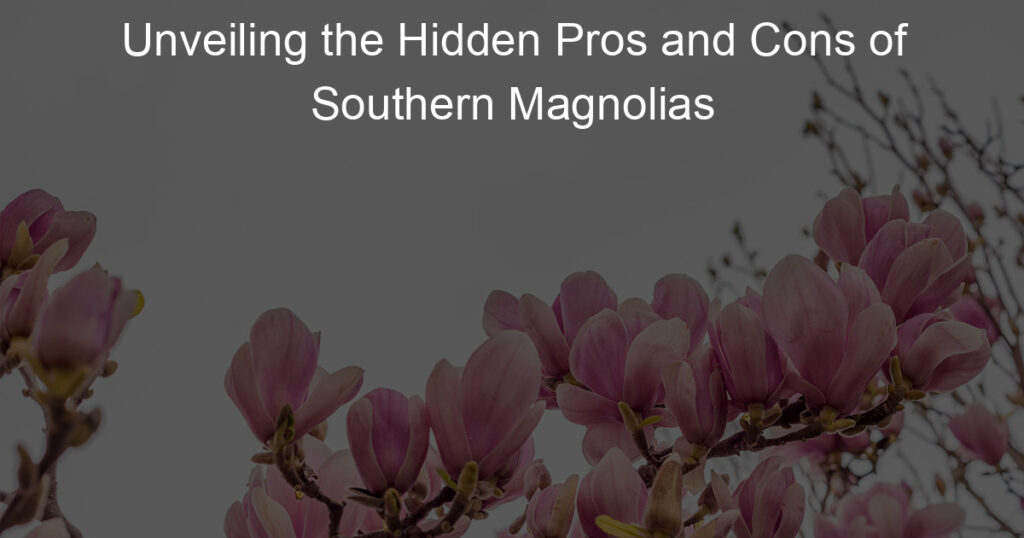
Introduction to Southern Magnolias
When it comes to trees that are both beautiful and resilient, the Southern Magnolia stands out. This tree, native to the southeastern United States, is known for its large, glossy leaves and fragrant, white flowers. In this section, we will delve into the characteristics and key facts about this remarkable tree.
-
Overview of Southern Magnolia Tree Characteristics
The Southern Magnolia, also known as Magnolia grandiflora, is a tree of grand proportions. It can reach heights of up to 80 feet and widths of up to 40 feet. It’s a slow-growing, evergreen tree, meaning it retains its lush, green leaves all year round. The leaves are large, leathery, and dark green on top with a fuzzy, rust-colored underside.
The tree’s most notable feature is its flowers. They bloom in the late spring and early summer, filling the air with a sweet, lemony scent. Each flower is large, often up to 12 inches in diameter, and pure white. The tree also produces a fruit that looks like a cone and contains bright red seeds.
-
Key Southern Magnolia Tree Facts
Fact Details Scientific Name Magnolia grandiflora Native Region Southeastern United States Height Up to 80 feet Width Up to 40 feet Flower Color White Bloom Time Late spring to early summer Leaf Color Dark green with rust-colored underside The Southern Magnolia is not just a pretty face. It’s a hardy tree that can withstand both heat and cold, and once established, it requires little care. It’s also a long-lived tree, with some specimens known to be over 100 years old. This combination of beauty and resilience makes the Southern Magnolia a popular choice for landscaping in many parts of the country.
Benefits of Southern Magnolias
The Southern Magnolia tree, a staple in many landscapes, offers a multitude of benefits. From its aesthetic appeal to its environmental contributions, this tree is a valuable addition to any garden or yard. Let’s delve into the pros of having a Southern Magnolia tree.
Magnolia Tree Pros
-
- Benefit 1: Aesthetic Appeal
The Southern Magnolia is renowned for its beauty. Its large, glossy green leaves and fragrant, creamy-white flowers provide a stunning visual display. The tree’s grand size and evergreen nature make it an attractive focal point in any landscape, enhancing the overall aesthetic appeal of the area.
-
- Benefit 2: Environmental Contributions
Aside from its beauty, the Southern Magnolia also plays a significant role in the environment. It provides shade and shelter for various wildlife and helps in air purification by absorbing pollutants. Its evergreen nature means it continues to photosynthesize in winter, contributing to a healthier environment year-round.
-
- Benefit 3: Low Maintenance
Another advantage of the Southern Magnolia is its low maintenance requirements. Once established, these trees are drought-tolerant and can thrive in a variety of soil types. They also have a high resistance to pests and diseases, making them a practical choice for those seeking a low-maintenance yet beautiful tree.
In conclusion, the Southern Magnolia tree is not only a beautiful addition to any landscape but also a beneficial one. Its aesthetic appeal, environmental contributions, and low-maintenance nature make it a valuable asset in any garden or yard.
Drawbacks of Southern Magnolias
While Southern Magnolias are renowned for their beauty and resilience, they also come with a few drawbacks. Let’s delve into some of the cons associated with these trees.
Magnolia Tree Cons
- Large Size: Southern Magnolias can grow to be quite large, reaching heights of up to 80 feet and spreading 30 to 50 feet wide. This makes them unsuitable for small yards or landscapes with limited space.
- Root System: These trees have a wide-spreading root system that can potentially damage sidewalks, driveways, and other structures. The roots can also compete with other plants for nutrients and water, which can affect the overall health of your garden.
- Maintenance: Southern Magnolias require a fair amount of maintenance. They shed their leaves year-round, which can create a mess and require regular clean-up. Additionally, they can be susceptible to certain pests and diseases, requiring regular monitoring and treatment.
Despite these drawbacks, many people find the beauty and charm of the Southern Magnolia worth the extra effort. With proper care and attention, these trees can be a stunning addition to any landscape.
Case Study: Growing Southern Magnolias
Let’s take a closer look at two real-life examples of growing Southern Magnolias. These case studies will provide practical insights and demonstrate the potential of these magnificent trees.
-
Case Study 1: The Johnson Family’s Southern Magnolia
The Johnson family, living in Atlanta, Georgia, decided to plant a Southern Magnolia in their backyard. They chose a sunny spot with well-drained soil, as recommended. After just one year, the tree had grown significantly and was already blooming with beautiful, fragrant flowers.
They watered the tree regularly, especially during dry spells, and pruned it annually to maintain its shape. The family also used a slow-release fertilizer to ensure the tree received all the necessary nutrients.
The result? A thriving Southern Magnolia that not only beautifies their property but also provides shade and attracts various bird species. This case study demonstrates the potential of Southern Magnolias when properly cared for.
-
Case Study 2: The Community Park’s Southern Magnolia
In a small town in Alabama, the community decided to plant a Southern Magnolia in the local park. Despite the challenging clay soil, they managed to grow a healthy tree by amending the soil with organic matter and ensuring proper drainage.
They also installed a watering system to provide the tree with consistent moisture. The community even organized a yearly “Magnolia Day,” where residents gather to celebrate the tree’s blooming and participate in educational activities about tree care.
Today, the tree stands tall and proud, serving as a symbol of community spirit and resilience. This case study shows that with collective effort and the right care, Southern Magnolias can thrive even in less-than-ideal conditions.
These case studies illustrate the beauty and benefits of Southern Magnolias. With the right care and attention, these trees can become a stunning addition to any landscape.
Magnolia Tree Care
Caring for your Southern Magnolia tree is a rewarding endeavor. These majestic trees, with their large, glossy leaves and fragrant flowers, can be a stunning addition to your landscape. However, they require specific care to thrive. Here are some tips to help you nurture your Southern Magnolia.
How to Nurture Your Southern Magnolia
Proper care of your Southern Magnolia involves understanding its needs and providing the right conditions for its growth. Let’s explore three key tips to help you in this process.
- Tip 1: Provide Adequate Water
Southern Magnolias need a moderate amount of water. Overwatering can lead to root rot, while underwatering can cause wilting. It’s recommended to water your tree deeply once a week during dry periods. Remember, the soil should be moist, not soggy. - Tip 2: Ensure Proper Sunlight
These trees love the sun. They thrive best in full sun to partial shade. However, young trees may need protection from intense afternoon sun. As your tree matures, it will be able to handle more sunlight. - Tip 3: Regular Pruning
Pruning helps maintain the health and shape of your Southern Magnolia. It’s best to prune in late winter or early spring before new growth starts. Remove dead or diseased branches, and trim back any branches that are growing out of shape.
By following these tips, you can ensure that your Southern Magnolia tree thrives and continues to add beauty to your landscape for years to come.
Southern Magnolia Tree Problems
While Southern Magnolia trees are a beautiful addition to any landscape, they can sometimes face certain problems. Let’s explore two common issues that these trees often encounter.
-
- Problem 1: Scale Insects
Scale insects are small bugs that attach themselves to the branches and leaves of the Southern Magnolia tree. They suck the sap from the tree, which can cause the leaves to turn yellow and fall off. If not treated, this problem can weaken the tree and stunt its growth.
-
- Problem 2: Fungal Diseases
Fungal diseases are another common problem for Southern Magnolia trees. One such disease is leaf spot, which causes brown or black spots on the leaves. This disease can lead to leaf drop and can affect the overall health of the tree. It’s important to treat any signs of fungal disease promptly to prevent it from spreading.
While these problems can be concerning, they are manageable with proper care and attention. Regularly inspect your Southern Magnolia tree for signs of these issues and take action as soon as you notice any problems. This will help ensure your tree remains healthy and beautiful for years to come.
Key Takeaways: Southern Magnolia Tree Benefits and Drawbacks
-
- Key Takeaway 1: Benefits of Southern Magnolia Trees
Southern Magnolia trees are not only a visually appealing addition to any landscape, but they also offer a variety of benefits. They are known for their large, glossy leaves and fragrant, white flowers which add beauty to any garden. These trees are also quite hardy and can withstand a variety of weather conditions, making them a practical choice for many gardeners. Furthermore, they provide shade and can even act as a natural sound barrier. Their flowers, leaves, and seeds also provide food for a variety of wildlife, contributing to local biodiversity.
- Key Takeaway 1: Benefits of Southern Magnolia Trees
- Key Takeaway 2: Drawbacks of Southern Magnolia Trees
While Southern Magnolia trees have many benefits, they also come with a few drawbacks. One of the main concerns is their size. These trees can grow quite large, which may not be suitable for smaller yards. They also shed their leaves year-round, which can lead to additional maintenance. Additionally, they have a dense root system that can interfere with underground utilities or other plants. Lastly, while they are generally hardy, they can be susceptible to certain pests and diseases, such as magnolia scale or leaf spot.
Conclusion
In this article, we’ve taken a comprehensive look at the Southern Magnolia tree, exploring its benefits, drawbacks, and the care it requires. We’ve also delved into a case study to understand the practical aspects of growing this tree. Now, let’s wrap up with some final thoughts on the pros and cons of Southern Magnolias.
-
- Final thoughts on the pros and cons of Southern Magnolias
The Southern Magnolia is a majestic tree that offers a host of benefits. Its large, glossy leaves and fragrant flowers add beauty to any landscape. It serves as a habitat for various birds and insects, contributing to biodiversity. Moreover, it’s a hardy tree that can withstand harsh weather conditions, making it a reliable choice for many gardeners.
However, it’s important to remember that this tree also has its drawbacks. Its large size requires ample space, and its roots can potentially cause damage to underground utilities. It also sheds leaves throughout the year, which might require regular cleanup. Lastly, it can be susceptible to certain pests and diseases, requiring vigilant care and maintenance.
Overall, whether the Southern Magnolia is a good fit for your garden depends on your specific circumstances and preferences. If you have the space and time to care for it, this tree can be a wonderful addition to your landscape. But if you’re looking for a low-maintenance option, you might want to consider other alternatives.
In conclusion, the Southern Magnolia is a tree of contrasts – its beauty and hardiness are balanced by its size and maintenance needs. As with any plant, it’s crucial to understand these aspects before deciding to grow one in your garden. We hope this article has provided you with the necessary information to make an informed decision.














